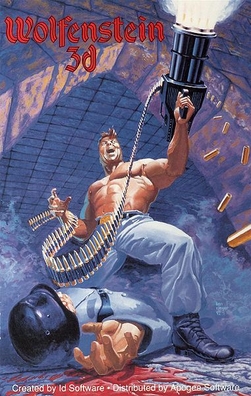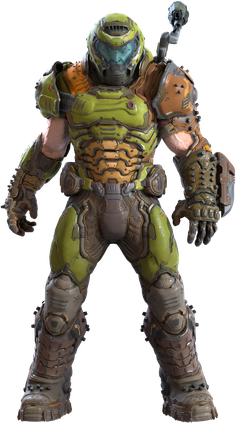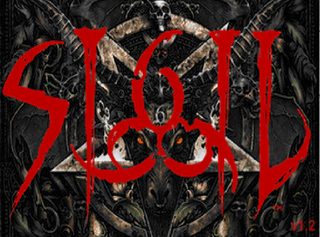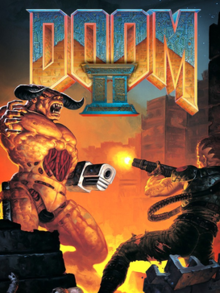
Doom is a first-person shooter game developed and published by id Software. Released on December 10, 1993, for DOS, it is the first installment in the Doom franchise. The player assumes the role of a space marine, later unofficially referred to as Doomguy, fighting through hordes of undead humans and invading demons. The game begins on the moons of Mars and finishes in hell, with the player traversing each level to find its exit or defeat its final boss. It is an early example of 3D graphics in video games, and has enemies and objects as 2D images, a technique sometimes referred to as 2.5D graphics.

Heretic is a dark fantasy first-person shooter video game released in December 1994. It was developed by Raven Software and published by id Software through GT Interactive.

id Software LLC is an American video game developer based in Richardson, Texas. It was founded on February 1, 1991, by four members of the computer company Softdisk: programmers John Carmack and John Romero, game designer Tom Hall, and artist Adrian Carmack.

Quake II is a 1997 first-person shooter video game developed by id Software and published by Activision. It is the second installment of the Quake series, following Quake. The game's storyline is continued in its expansions, including one tying in Quake II and the first game, and Quake 4.

Quake is a first-person shooter game developed by id Software and published by GT Interactive. The first game in the Quake series, it was originally released for MS-DOS, Microsoft Windows, and Linux in 1996, followed by Mac OS and Sega Saturn in 1997 and Nintendo 64 in 1998. In the game, players must find their way through various maze-like, medieval environments while battling monsters using an array of weaponry. Quake takes inspiration from gothic fiction and the works of H. P. Lovecraft.

Wolfenstein 3D is a first-person shooter video game developed by id Software and published by Apogee Software and FormGen. Originally released on May 5, 1992, for DOS, it was inspired by the 1981 Muse Software video game Castle Wolfenstein, and is the third installment in the Wolfenstein series. In Wolfenstein 3D, the player assumes the role of Allied spy William "B.J." Blazkowicz during World War II as he escapes from the Nazi German prison Castle Wolfenstein and carries out a series of crucial missions against the Nazis. The player traverses each of the game's levels to find an elevator to the next level or kill a final boss, fighting Nazi soldiers, dogs, and other enemies with a knife and a variety of guns.

Alfonso John Romero is an American director, designer, programmer and developer in the video game industry. He is a co-founder of id Software and designed their early games, including Wolfenstein 3D (1992), Doom (1993), Doom II (1994), Hexen (1995) and Quake (1996). His designs and development tools, along with programming techniques developed by id Software's lead programmer, John Carmack, popularized the first-person shooter (FPS) genre. Romero is also credited with coining the multiplayer term "deathmatch".

Doom 3 is a 2004 survival horror first-person shooter video game developed by id Software and published by Activision. Doom 3 was originally released for Microsoft Windows on August 3, 2004, adapted for Linux later that year, and ported by Aspyr Media for Mac OS X in 2005. Developer Vicarious Visions ported the game to the Xbox, releasing it worldwide on April 4, 2005.

Quake 4 is a 2005 first-person shooter video game developed by Raven Software and published by Activision. It is the fourth title in the Quake series, after the multiplayer Quake III Arena, and a sequel to Quake II. Raven Software collaborated with id Software, who supervised the development of the game as well as provided the id Tech 4 engine upon which it was built. The game has an increased emphasis on single-player gameplay compared to previous installments; its multiplayer mode does not support playable bots.
Doom WAD is the default format of package files for the video game Doom and its sequel Doom II: Hell on Earth, that contain sprites, levels, and game data. WAD stands for Where's All the Data? Immediately after its release in 1993, Doom attracted a sizeable following of players who created their own mods for WAD files—packages containing new levels or graphics—and played a vital part in spawning the mod-making culture which is now commonplace for first-person shooter games. Thousands of WADs have been created for Doom, ranging from single custom levels to full original games; most of these can be freely downloaded over the Internet. Several WADs have also been released commercially, and for some people the WAD-making hobby became a gateway to a professional career as a level designer.

Doom 3: Resurrection of Evil is a survival horror first-person shooter video game developed by Nerve Software and published by Activision. It was released for Microsoft Windows worldwide on April 4, 2005, as an expansion pack and sequel to Doom 3 and on October 5, 2005, for the Xbox video game console. The Xbox version does not require the original Doom 3 in order to play, and includes The Ultimate Doom, Doom II: Hell on Earth and Master Levels for Doom II. A remastered version of Resurrection of Evil was included with Doom 3: BFG Edition.

Final Doom is a first-person shooter video game developed by TeamTNT, and Dario and Milo Casali, and was released by id Software and distributed by GT Interactive in 1996. It was released for MS-DOS and Macintosh computers, as well as for the PlayStation, although the latter featured a selection of levels from Final Doom and from Master Levels for Doom II.
Doom, a first-person shooter game by id Software, was released in December 1993 and is considered one of the most significant and influential video games in history. Development began in November 1992, with programmers John Carmack and John Romero, artists Adrian Carmack and Kevin Cloud, and designer Tom Hall. Late in development, Hall was replaced by Sandy Petersen and programmer Dave Taylor joined. The music and sound effects were created by Bobby Prince.

Doom 64 is a first-person shooter game by Midway. It was first released for the Nintendo 64 in 1997, as the second spin-off game in the Doom series after Final Doom (1996), and the fourth game in the series overall. A remastered port was developed by Nightdive Studios and published by Bethesda Softworks for Nintendo Switch, PlayStation 4, Windows, and Xbox One in March 2020, and for Stadia in May 2020.

Doomguy is the protagonist of the Doom game series by id Software. He was created by American video game designer John Romero and was introduced as the player character in the original 1993 video game Doom. Within the Doom series, Doomguy is a demon hunter space marine dressed in green combat armor who rarely speaks onscreen, and his personality and backstory were intentionally vague to reinforce his role as a player avatar. In Doom Eternal, he is voiced by American voice actor Matthew Waterson, while Jason Kelley voices the character in that game's downloadable content The Ancient Gods: Part Two, and was portrayed by Karl Urban in the 2005 film adaptation. He has appeared in several other games developed by id Software, including Quake Champions and Quake III Arena.

Doom is a 2016 first-person shooter video game developed by id Software and published by Bethesda Softworks. The game is the first major installment in the Doom series since 2004's Doom 3 and was a reboot of the franchise. It was released for PlayStation 4, Windows, and Xbox One in May 2016. A port for Nintendo Switch was co-developed with Panic Button and released in November 2017, and a version for Google Stadia was released in August 2020. Players take the role of an unnamed space marine, known as the "Doom Slayer", as he battles demonic forces within an energy-mining facility on Mars and in Hell.

Doom is an American media franchise created by John Carmack, John Romero, Adrian Carmack, Kevin Cloud, and Tom Hall. The series usually focuses on the exploits of an unnamed space marine operating under the auspices of the Union Aerospace Corporation (UAC), who fights hordes of demons and the undead to save Earth from an apocalyptic invasion.

Doom Eternal is a 2020 first-person shooter game developed by id Software and published by Bethesda Softworks. The sequel to Doom (2016), and the seventh game in the Doom series, it was released for PlayStation 4, Stadia, Windows, and Xbox One on March 20, 2020, with a port for Nintendo Switch released on December 8, 2020, and versions for PlayStation 5 and Xbox Series X/S released on June 29, 2021.

Sigil is the unofficial fifth episode of the 1993 video game Doom. Published by Romero Games on May 31, 2019, the Megawad was created by an original co-creator of Doom, John Romero, independently of the main game's then-current owner, Bethesda Softworks. It has nine missions, each with a deathmatch version, and a new soundtrack created by James Paddock and Buckethead. While initially released independently, Bethesda later released the episode as a patch for the console ports of Doom.


















